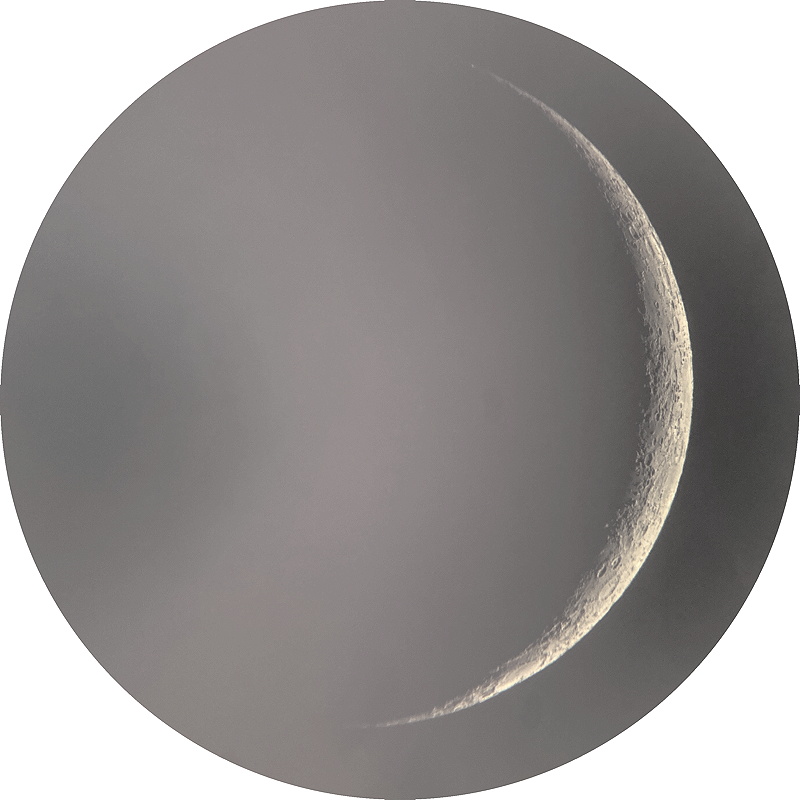Jupiter & Saturn Conjunction 32' 13" with Crescent Moon
Posted: 17 December 2020
|
Open: Wednesday, 16 December 2020, 1710 MST Temperature: 65°F |
Session: 1572 Conditions: Clear |
Equipment:
12" f/8 LX600 w/StarLock
2" 24mm UWA eyepiece
2" 30mm eyepiece
Camera:
iPhone 11 Pro Max
D850 DSLR
1714 MST: LX600 ON, StarLock OFF, High Precision OFF.
1717 MST: viewed the crescent Moon, 102X.
Viewed Jupiter and Saturn, 102X. With the planets separated by 32' 13" they were both visible in the same eyepiece field-of-view.
I set up the D850 DSLR with 150-600mm lens on the observatory patio.

1720 MST: sunset (approximate).
Viewed Jupiter and Saturn, 81X. Nice sight.
Slewed back to the Moon. Mounted the iPhone 11 Pro Max on the 2" 30mm eyepiece using the Levenhuk adapter. Took this NightCap Camera image (ISO 32, 1/200sec, 1X lens).

1737 MST: viewed the Moon with Earthshine, 12x50 binoculars. The planets were just outside the 4.6° FOV of the binoculars.
1742 MST: viewed Jupiter, 81X. The four Galilean Moons were visible, two on each side, with two very close to each side of the Jovian disk.
1755 MST: stepped outside of the observatory and took this iPhone photo of the sky and the D850 DSLR. Jupiter is visible above the Moon (with Earthshine). The Moon and Jupiter are visible on the Live View screen on the D850 DSLR camera.

This D850 DSLR photo (f/8, 1/4sec, ISO 1600, FL 300mm) shows the Moon, Earthshine, Saturn, and Jupiter (with two moons visible).

Back at the 12" telescope, this iPhone 11 Pro Max afocal 81X photo with NightCap Camera (ISO 800, 1/70sec, 1X lens) shows both planets in the eyepiece.

This longer exposure (ISO 800, 1 second, 1X) shows two moons at Jupiter and four moons at Saturn.

Mouseover or tap on image for labels
1835 MST: I then tried to image both planets projected onto the observatory dome but the twilight sky and the Moon made the scene a little too bright to capture Saturn's projected image at 81X. Jupiter is the bright white spot just to the left of the telescope in this photo (f/6.3, 30 seconds, ISO 8000, FL 24mm)

1856 MST: the western sky and the observatory with the D850 DSLR (f/8, 5 seconds, ISO 2500, FL 52mm, slight crop). Jupiter and Saturn are at the upper right corner.

1900 MST: final look at Jupiter and Saturn, 102X.
1907 MST: LX600 OFF.
1918 MST: took a Sky Quality reading.
|
Close: Wednesday, 16 December 2020, 1921 MST Temperature: 46°F |
Session Length: 2h 11m Conditions: Clear, SQM 21.00 |
Comments are welcome using Email. Twitter users can use the button below to tweet this report to their followers. Thanks.
Cassiopeia Observatory Home Page
Copyright ©2020 Michael L. Weasner / mweasner@me.com
URL = http://www.weasner.com/co/Reports/2020/12/17/index.html
